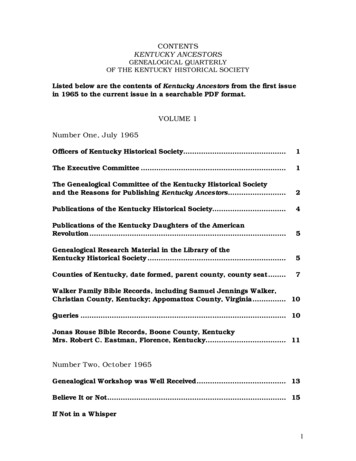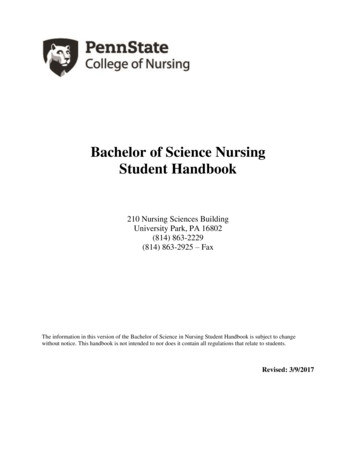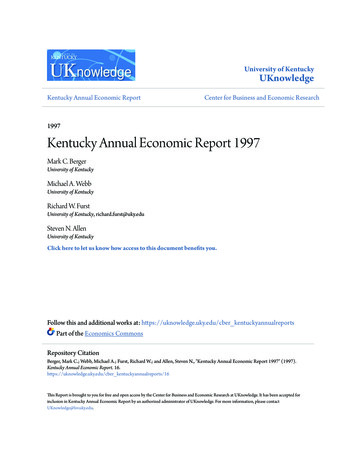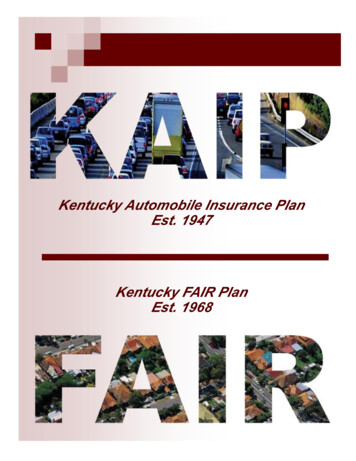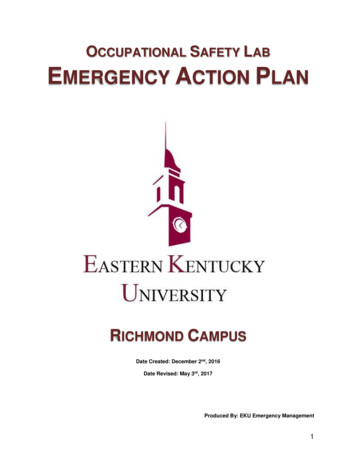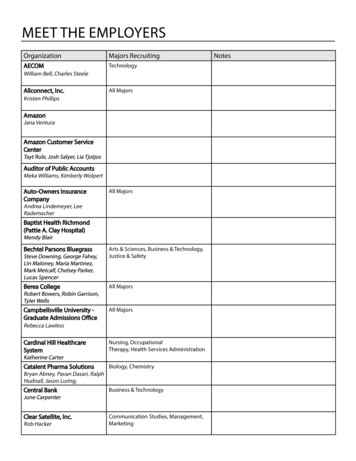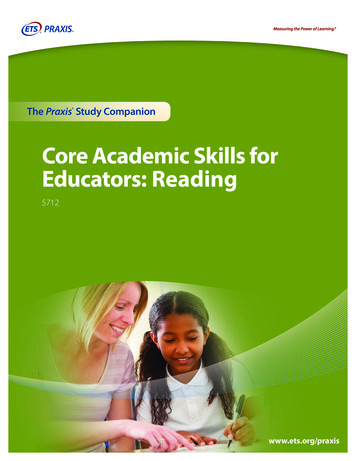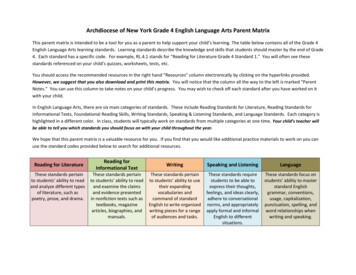
Transcription
Kentucky Academic StandardsReading and WritingAdopted 20191
IntroductionBackgroundKentucky’s Vision for StudentsLegal BasisPromulgation of the RegulationStatuteStandards Creation Process667778Writers’ Vision StatementDesign ConsiderationsGuiding Principles and Grade-Specific StandardsBalance of Building Knowledge and Applying Skills and StrategiesEarly LiteracyInterdisciplinary Literacy PracticesMultidimensionalityDistribution of Literacy and Informational Text21st Century Literacy8999910101011Standards Use and DevelopmentThe Kentucky Academic Standards (KAS) are Standards, not CurriculumTranslating the Standards into CurriculumOrganization of the StandardsStrands and CodingGuiding PrinciplesInterdisciplinary Literacy PracticesMultidimensionalityStandard Breakdown111111121213141516Guiding principlesGuiding principles for reading literature and informational textGuiding principles for compositionGuiding principles for language17171819Grade Level OverviewsKindergarten-grade 5 overviewGrade 6-8 overviewGrade 9-12 overview202223192
Kentucky Academic Standards: Reading and WritingKindergarten-Grade 5 OVERVIEW20KindergartenReading foundationsReading literatureReading informational e 1Reading foundationsReading literatureReading informational e 2Reading foundationsReading literatureReading informational rade 3Reading foundationsReading literatureReading informational 493
Kentucky Academic Standards: Reading and Writing (CONTINUTED)Grade 4Reading foundationsReading literatureReading informational textCompositionLanguage156157163169182Grade 5Reading foundationsReading literatureReading informational textCompositionlanguage189190196202215Grade 6-8 OVERVIEW222Grade 6Reading literatureReading informational textCompositionlanguage223229235248Grade 7Reading literatureReading informational textCompositionlanguage255261267280Grade 8Reading literatureReading informational textCompositionlanguage2872932993124
Kentucky Academic Standards: Reading and Writing (CONTINUTED)Grade 9-12 OVERVIEW319Grade 9-10Reading literatureReading informational textCompositionlanguage320326332345Grade 11-12Reading literatureReading informational isciplinary Literacy Practices with InfographicProgressionsAppendix A: Writing and Review Committees3843914575
Kentucky Academic StandardsReading and WritingINTRODUCTIONBackgroundPreparation of Kentucky’s students for the demands of the 21st Century requires districts and schools to prepare every student for successful transitionto post-secondary education, work and the community. The Kentucky Academic Standards for Reading and Writing help ensure all students throughoutKentucky are provided with common content and have opportunities to learn at high levels. Students need vast literacy abilities and ever-changing technological competencies. This broadened definition of literacy means English/language arts education must address many different types and uses of language. The instructional programs for Kentucky’s public schools emphasize the development of students’ abilities to acquire, apply and integrateknowledge, skills and understandings in real life contexts and to problem-solve, make decisions and think critically and creatively. They assist students inconnecting learning to the world beyond the classroom by exploring and investigating real issues and problems of communities, states, the nation andthe world. Well-designed Reading and Writing standards, curriculum and instruction recognizes the diversity of students and how children learn, construct knowledge and acquire skills and concepts of the disciplines.Kentucky’s Vision for StudentsEnglish/language arts education develops skills, knowledge and dispositions (e.g. content, comprehension and analysis) that directly align with the Kentucky Board of Education’s (KBE) vision that each and every student is empowered and equipped to pursue a successful future. To equip and empowerstudents, the following capacity and goal statements frame instructional programs in Kentucky schools. They were established by the Kentucky Education Reform Act (KERA) of 1990, as found in Kentucky Revised Statute (KRS) 158.645 and KRS 158.6451. All students shall have the opportunity to acquirethe following capacities and learning goals: Communication skills necessary to function in a complex and changing civilization;Knowledge to make economic, social and political choices;Understanding of governmental processes as they affect the community, the state and the nation;Sufficient self-knowledge and knowledge of their mental health and physical wellness;Sufficient grounding in the arts to enable each student to appreciate their cultural and historical heritage;Sufficient preparation to choose and pursue their life’s work intelligently; andSkills to enable students to compete favorably with students in other states and other parts of the world.Furthermore, schools shall: Expect a high level of achievement from all students.Develop their students’ ability to: Use basic communication and mathematics skills for purposes and situations they will encounter throughout their lives;6
Apply core concepts and principles from mathematics, the sciences, the arts, the humanities, social studies, English/language arts, health,practical living, including physical education, to situations they will encounter throughout their lives; Become self-sufficient individuals; Become responsible members of a family, work group or community as well as an effective participant in community service; Think and solve problems in school situations and in a variety of situations they will encounter in life; Connect and integrate experiences and new knowledge from all subject matter fields with what students have previously learned and buildon past learning experiences to acquire new information through various media sources; and Express their creative talents and interests in visual arts, music, dance and dramatic arts.Increase student attendance rates.Reduce dropout and retention rates.Reduce physical and mental health barriers to learning.Be measured on the proportion of students who make a successful transition to work, postsecondary education and the military.To ensure legal requirements of English/language arts classes are met, the Kentucky Department of Education (KDE) encourages schools to use the Model Curriculum Framework to inform development of curricula related to these courses. The Model Curriculum Framework encourages putting the student at the center ofplanning to ensure that: the goal of such a curriculum is to produce students that are ethical citizens in a democratic global society and to help them become self-sufficient individuals who are prepared to succeed in an ever-changing and diverse world. Design and implementation requires professionals to accommodate theneeds of each student and focus on supporting the development of the whole child so that all students have equitable access to opportunities and support for maximum academic, emotional, social and physical development.(Model Curriculum Framework, page 19)Legal BasisThe following Kentucky Revised Statutes (KRS) and Kentucky Administrative Regulations (KAR) provide a legal base for this publication: KRS 156:160KRS 156.160 Promulgation of administrative regulations by the Kentucky Board of EducationWith the advice of the Local Superintendents Advisory Council (LSAC), the KBE shall promulgate administrative regulations establishing standards thatpublic school districts shall meet in student, program, service and operational performance. These regulations shall comply with the expected outcomesfor students and schools set forth in KRS 158:6451.704 KAR 3:305 Minimum high school graduation requirementsThis administrative regulation establishes the minimum high school graduation requirements necessary for entitlement to a public high school diploma,including the requirements for the graduating class of 2012 .7
704 KAR 8:020 Reading and Writing StandardsThis administrative regulation adopts into law the Reading and Writing Standards.Senate Bill 1 (2017) Required Revision of Academic StandardsBeginning in 2017-18 and every six years thereafter, the KBE shall implement a process for reviewing Kentucky's academic standards and thealignment of corresponding assessments for possible revision or replacement to ensure alignment with postsecondary readiness standards necessary for global competitiveness.Standards Creation ProcessThe standards creation process focused heavily on educator involvement. Kentucky teachers understood elementary and secondary academic standardsmust align with postsecondary readiness standards and career and technical education standards. They wanted students to be prepared for the jobs ofthe future and to compete with students from other states and nations.The English/language arts Advisory Panel was composed of 27 teachers, three public post-secondary professors from institutions of higher education andtwo community members. The function of the Advisory Panel was to review the standards and make recommendations for changes to a Review Development Committee. In addition to the standards’ revisions, the Advisory Panel created a new architectural structure for the standards. The English/language arts Standards Review and Development Committee was composed of six teachers, three public post-secondary professors from institutions ofhigher education and one community member. The function of the Review and Development Committee was to review the work and findings from theAdvisory Panel and make recommendations to revise or replace existing standards.Members of the Advisory Panels and Review and Development Committee were selected based on their expertise in the area of English/language arts, aswell as being a practicing teacher in the field of English/language arts. The selection committee considered statewide representation, as well as bothpublic secondary and higher education instruction, when choosing writers (Appendix A).WRITERS’ VISION STATEMENTThe writing team was guided by principles rooted in the belief that Kentucky teachers are consummate professionals driven by the altruistic desire to dowhat is best for their students. They envisioned standards constructed from language that is clear and directive, but not prescriptive. The standards wererewritten to consolidate redundancies, to reflect the current state of evidence-based research and to align the incremental expectations among gradelevels. They wanted teachers, schools and districts to be empowered to deliver curriculum that meets the expectations set forth by the standards. Theyalso wanted the architecture to be useful and practical for teachers as they consult the standards in their daily work. The vision of the writers for theReading and Writing standards was created by educators for educators with the purpose of preparing each and every Kentucky student for a productivepost high school transition.8
The KDE provided the following foundational documents to inform the writing team’s work: Review of state academic standards documents (Indiana, Iowa, Ohio, Louisiana, Massachusetts, New York)Achieve. (2017). Strong Standards: A Review of Changes to State Standards Since the Common Core. Washington, D.C. Retrieved from file:///C:/Users/whamilto/Downloads/17-224 Achieve CombinedStandardsReport11.8.pdfDewitt, Jones and Leahy. (2009). Comprehension Strategy Instruction in Core Reading Programs. Reading Research Quarterly, 44(2), 102-126.International Reading Association & National Council of the Teachers of English (1996). Standards for English Language Arts. Newark, Delaware. Retrievedfrom oks/Sample/StandardsDoc.pdfShanahan, Tim. (2018). Knowing and Reading--What Can We Do to Make Sure Kids Know Enough to Comprehend. Shanahan on Literacy. Retrieved -enough-tocomprehend#sthash.YxwHtKjn.dpbs.Wexler, Natalie. (2018). Why American Students Haven't Gotten Better at Reading in 20 Years. The Atlantic. Retrieved from /04/-american-students-reading/557915/Design ConsiderationsGuiding Principles and Grade-Specific StandardsThe Guiding Principles define general, interdisciplinary literacy expectations that must be met for students to be transition ready. The K—12 grade-specificstandards define end-of-year expectations and a cumulative progression designed to enable students to become transition ready no later than the end ofhigh school. They are not anchored at the end of high school, but rather they are ongoing elements of literacy that can be applied by students as they transition to college and/or a career path. The grade-level standards provide additional specificity and context for the appropriate application of the Guiding Principles. Students advancing through the grades are expected to meet each year’s grade-specific standards, retain or further develop skills and understandings inpreceding grades and work steadily toward meeting the broader expectations described by the Guiding Principles.Balance of Building Knowledge and Applying Skills and StrategiesThe standards place equal emphasis on the sophistication of what students read and the skill with which they read. For example, Reading Literature andReading Informational Text Standard 10 defines a grade-by-grade “staircase” of increasing text complexity that rises from beginning reading and incorporatesthe reading strategies as the foundation to comprehension. Current research and best practice suggest that students comprehend texts best when they areable to activate schema, make meaning and recognize vocabulary. Exposing students to multiple texts and interdisciplinary content provides opportunities tobuild knowledge in meaningful ways. Thus, students should be encouraged to read about their interests and curiosities and to see the transference and application of knowledge between English/language arts and other content areas, such as science, social studies and math. They also should further thatknowledge by writing about what they are reading and their existing understanding of terms, concepts and processes.Early LiteracyTo reinforce the importance of early literacy, the K-5 Kentucky Academic Standards for Reading and Writing include expectations for reading literary and informational texts, composition, language and foundational skills applicable across disciplines. The revisions to the K-5 standards align with and build upon theearly childhood standards, providing a developmentally appropriate progression as students transition from preschool to kindergarten.9
They articulate rigorous grade-level expectations essential to developing a strong infrastructure of essential early literacy skills in order to equip studentswith the skills and knowledge critical to be successful in later years and, ultimately, transition ready. For example, the reading literature and reading informational text strands introduce inferring in kindergarten rather than waiting until third grade as in the previous standards document. The standards alsoaddress the need to teach comprehension strategies beginning in kindergarten and continuing through grade 12 because of their importance in aidingcomprehension. Changes like these provide intentional opportunities for students’ critical thinking skills to begin developing much sooner than before andpromotes the activation of those skills as students learn to process the meaning of texts through comprehension and analysis in early primary.Interdisciplinary Literacy PracticesThe Interdisciplinary Literacy Practices are built upon a foundation of common understandings — or practices —which provide the overarching goals for literacy instruction for each student across the state. These ten foundational practices are fundamental to fostering an environment that goes beyond teaching and learning isolatedskills. This literacy-rich environment focuses on the larger vision and objective of empowering independent, lifelong learners who think deeply and critically about text. The practices should not be confused as additionalstandards, but they should guide teachers in providing intentional opportunities for students to practice thebehaviors of a literate citizen.The ten interdisciplinary literacy practices are further clarified by possible teacher and student actions. Theseactions do not define curriculum, but rather they demonstrate how teachers can provide opportunities for students to experience the literacy practices and how students will apply these practices, so they may become aninnate part of life across the disciplines and beyond school.Figure 1 Interdisciplinary Literacy Practices InfographicMultidimensionalityThe Reading, Composition and Language Standards consist of multiple dimensions or layers. The skills andcontent provide the “what” to help students access concrete and abstract “thinking” needed to practice the “doing” of reading and composing within thediscipline. The previous literacy standards document lacked a focused dimensional approach; as a result, the perceived depth of a standard may havebeen limited to comprehension due to interpretation or deconstruction of opaque wording. By specifying the 3 dimensions separately, this standards document better communicates the intent of each standard so that local instruction and assessment will align to the intended depth. In planning and instruction, teachers will need to know when to utilize the interdependence of a text’s level of comprehension and analysis to develop the students’ skills andknowledge to become independent and proficient thinkers.Distribution of Literary and Informational TextThe standards contain both a reading strand for literature and for informational text. Informational texts also are referenced in Composition ResearchStandards 5 and 6. Literary and informational texts are distinguished in two separate strands due primarily to the varied purposes for which students readdifferent texts and the structural differences that mark the text types. In K-5, the standards follow the National Assessment of Educational Progress (NAEP)10
Reading Framework (2017) for balancing the reading of literature with the reading of informational texts, including texts in history/social studies, science andtechnical subjects. In 6-12, the standards are in accordance with NAEP’s increased emphasis on informational texts. As a result, in the higher grades, the distribution requires a significant amount of reading informational texts take place in and outside the ELA classroom. Thus, to ensure transition readiness, studentsmust be exposed to a wide variety of complex, grade-level texts, so they are equipped to read, comprehend and analyze texts as literate citizens in the 21st century.21st Century LiteracyThe digital media skills and understandings are embedded throughout the Interdisciplinary Literacy Practices and standards rather than addressed in a separatesection. The Practices focus on students recognizing digital media as text, and Practice 7 states that students must “[u]tilize digital resources to learn and sharewith others.” The Writing strand has been revised and renamed as the Composition strand to denote the impact of digital literacy on the process of composing.Student composition should not be limited to writing on paper or drafting in a word processing document; instead, they should use digital resources to create,publish, research and update individual or shared products and to take advantage of technology’s capacity to link to other information and to display information flexibly and dynamically.STANDARDS USE AND DEVELOPMENTThe Kentucky Academic Standards (KAS) are Standards, not CurriculumThe Kentucky Academic Standards for Reading and Writing outline the minimum content standards Kentucky students should learn in each grade-level English/language arts course. The standards address what is to be learned but do not address how learning experiences are to be designed or what resources should beused.A standard represents a goal or outcome of an educational program. The standards do not dictate the design of a lesson plan or how units should be organized.The standards establish what students should know and be able to do at the conclusion of a course. The instructional program should emphasize the development of students' abilities to acquire and apply the standards. The curriculum must assure that appropriate accommodations are made for diverse populationsof students found within Kentucky schools.These standards are not a set of instructional or assessment tasks. They are statements of what students should be able to do after instruction. Decisions onhow best to help students meet these program goals are left to local school districts and teachers.Translating the Standards into CurriculumThe KDE does not require specific curriculum or strategies to be used to teach English/language arts, only the Kentucky Academic Standards (KAS). Local schoolsand districts choose to meet those minimum required standards using a locally adopted curriculum. As educators implement academic standards, they, alongwith community members, must guarantee 21st-century readiness that will ensure all learners are transition-ready. To achieve this, Kentucky students need a11
curriculum designed and structured for a rigorous, relevant and personalized learning experience, including a wide variety of learning opportunities. TheKentucky Model Curriculum Framework serves as a resource to help an instructional supervisor, principal and/or teacher leader revisit curriculum planning,offering background information and exercises to generate “future-oriented” thinking while suggesting a process for designing and reviewing the local curriculum.Organization of the StandardsThe Kentucky Academic Standards for Reading and Writing consist of the Reading Literature, Reading Informational Text, Composition, Language, Handwriting Skills (K-3) and Foundational Skills (K-5) strands. To parallel the federal Every Student Succeeds Act, Kentucky’s standards are titled Kentucky Academic Standards for Reading and Writing; however, the review committee intentionally chose to include a Composition strand rather than a Writing strand.They envisioned writing as more than the traditional use of paper and pencil or word processing as 21st Century literacy encompasses the use of digital resources to create, publish and research. The strands outline what a student should know and be able to do independently by the end of each grade ingrades K-8 and each grade band for 9-10 and 11-12. Forming grade bands at the high school level allows schools and districts flexibility in course design.These grade-level specific and grade-banded standards intentionally support the learning progression as they strategically stair step students toward theguiding principles for each strand. The guiding principles represent broad statements about the expectations for students as they prepare for life after highschool. In short, attainment of grade-level standards should prepare students to achieve the guiding principles.Strands and CodingThe coding for the standards begins with an abbreviation of the strand followed by the grade-level in the middle and the standard number at the end.Strand abbreviations include RL for reading literature, RI for reading informational texts, C for composition (formerly labeled W for writing), L forlanguage, HW for handwriting and RF for Reading Foundational Skills.StrandAbbreviationExampleMeaningReading LiteratureRLRL.7.2Reading Literature, Grade 7, Standard 2Reading InformationalRIRI.5.5Reading Informational Text, Grade 5, Standard 5CompositionCC.9-10.1aComposition, Grades 9-10, Standard 1, Substandard aLanguageLL.11-12.5bLanguage, Grades 11-12, Standard 5, Substandard bHandwritingHWHW.K.1Handwriting, Kindergarten, Standard 1Reading Foundational SkillsRFRF.K.3cReading Foundational Skills, Kindergarten, Standard 3, Substandard c12
Guiding PrinciplesGuiding Principles frame each strand of the Reading and Writing standards. The guiding principles represent broad statements about the expectationsfor students after high school graduation. The number of guiding principles dictates the number of standards for a given strand. The Reading strandshave ten principles, which are the same for both Literature and Informational Text. In the Composition Strand, there are seven guiding principles, andthere are five guiding principles in the Language strand.The Guiding Principlesare listed on everygrade-level standardspage and viewablewithin each standardbreakdown.13
Interdisciplinary Literacy PracticesThe ten Interdisciplinary Literacy Practices are visible and numbered 1-10 on each main standards page to the right of the standards to emphasize the strongconnection between standards and practices. It is important for teachers to embed opportunities for students to experience the practices daily as they teachthe standards and create a literacy-rich environment.The tenInterdisciplinaryLiteracy Practicesare included on eachgrade-levelstandards page.14
MultidimensionalityCoding is used to show how each individual standard is multidimensional. The dimensions are denoted as follows:WORDS IN ALL CAPS AND IN MAROON CONTENTWords in Italics and in Green ComprehensionWords in Bold and in Purple AnalysisThe tools of an author and the objectsof literacy woven into the skills students must access and apply whendeveloping comprehension and performing analysisThis concrete dimension requires theobjective understanding of a text, topicor convention of language.This abstract dimension requires morethan objective understanding of mainideas and key details. The ability toread “between or above the lines” ishow students become critical thinkers.Examples: central idea, theme, tone,structure, syntaxExamples: decoding language and wordsin context, being able to effectively summarize or retell what has been read,knowing the grammar ruleExamples: critical reading to determine underlying meaning and purpose, determining WHY an authormade particular choices, being able toeffectively explain inferences andwhat is implied.Example of a standard coded for multidimensionality:RI.7.2Determine CENTRAL IDEAS of a text and analyze their development through citingtextual evidence, paraphrasing or summarizing.15
Standard BreakdownEach standard can be viewed with the guiding principle, progression and multidimensionality in the standard breakdown as shown below .The guiding principle, or broader goal bygraduation, is located at the top of thestandard breakdown.The progression places the main standard in the middle, the matching standard for the preceding grade to the leftand grade after standard to the right.The dimensionality of the main standard, the standard in the middle of theprogression above, is provided.Standard Breakdown KeyImageWhat it RepresentsMeaningGuiding PrincipleThe graduation cap signifies the guiding principles as theyare broad statements about the expectations for students asthey prepare for life after high school.ProgressionThe arrow signifies the progression of the standards as theyadvance from kindergarten to grade 12.MultidimensionalityThe layers signify the standard is coded to reflect the content, comprehension and analysis within the standard.16
InterdisciplinaryLiteracy PracticesGuiding Principles for Reading Literature and Informational TextKey Ideas and Details1Students will read closely to determine what the text says explicitly and to make logical inferencesfrom it; cite specific textual evidence to support conclusions drawn from the text.1Recognize that text is anything thatcommunicates a message.2Students will determine central ideas or themes of a text and analyze their development; cite specifictextual evidence, including summary, paraphrase and direct quotations, to support conclusionsdrawn from the text.2Employ, develop and refine schemato understand and create text.3Students will analyze how and why individuals, events, and ideas develop and interact over thecourse of a text.3View literacy experiences as transactional, interdisciplinary and transformational.4Utilize receptive and expressive language arts to better understand self,others and the world.5Apply strategic practices, withscaffolding and then independently,to approach new literacy tasks.6Collaborate with others to createnew meaning.7Utilize digital resources to learn andshare with others.8Engage in specialized, disciplinespecific literacy practices.9Apply high level cognitive processesto think deeply and critically abouttext.10Develop a literacy identity that promotes lifelong learning.Craft and Structure4Students will interpret words and phrases as they are used in a text, including determining technical,connotative and figurative meanings, and analyze how specific word choices shape meaning or tone.5Students will analyze the structure of texts, including how specific sentences, paragraphs and largerportions of the text relate to each other and the whole.6Students will analyze how point of view, perspective and purpose shape the content and style of atext.Integration of Knowledge and Ideas789Students will integrate and evaluate content presented in print/non-print forms of text found in diverse media and formats.Students will delineate and evaluate the argument, specific claims and evidence in a text,assessing the validity, reasoning, relevance and sufficiency.Students will analyze how two or more texts a
Grade 4 Reading foundations 156 Reading literature 157 Reading informational text 163 omposition 169 Language 182 Grade 5 Reading foundations 189 Reading literature 190 Reading informational text 196 omposition 202 language 215 Grade 6-8 OVERVIEW 222 Grade 6 Reading literature 223 Reading
